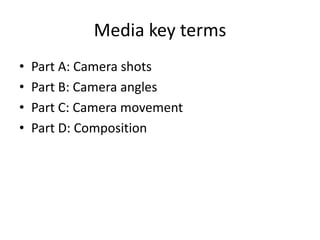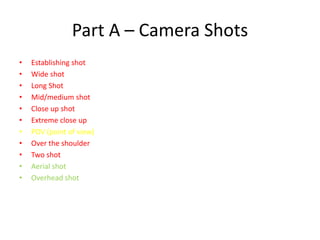Assignment 4 camera shots, camera angles,
- 1. Assignment 4- Camera shots, camera angles, camera movement and composition. Level – Yellow Ingrid De Souza
- 2. Media key terms • Part A: Camera shots • Part B: Camera angles • Part C: Camera movement • Part D: Composition
- 3. Part A – Camera Shots • Establishing shot • Wide shot • Long Shot • Mid/medium shot • Close up shot • Extreme close up • POV (point of view) • Over the shoulder • Two shot • Aerial shot • Overhead shot
- 4. Establishing shot The establishing shot establishes the setting of the scene. It is usually used at the beginning of a scene.
- 5. Wide shot The wide shot can be different shots from different distance to show the people in the room. E.G. If the characters are having a family dinner, a wide shot would be used to show the whole family around the table.
- 6. Long shot A long shot is usually used for framing a character, an object by their whole body.
- 7. Mid/Medium shot The mid/medium shot frames shots of a character from their waist and up. This shot is usually used to capture the characters dialogue and to show their facial expressions.
- 8. Close up shot A close up shot assemble a character or an object of some particular part of their body or face. However, it’s mainly used to show facial expressions and their emotions.
- 9. Extreme close up shot A extreme close up is a shot that is used to capture part of the body or face to show detail to the audience. It is also used to show more detail of the characters facial expression.
- 10. P.O.V (point of view) The POV shot demonstrates the character’s perspective. The camera has to be able to imitate how the human body moves, however it also depends where it’s placed.
- 11. Over the shoulder shot An over the shoulder shot is a shot which is filmed as if it’s from the back of a character’s shoulder.
- 12. Two shot Two shot can be used to frame two characters in one scene. It can be used to demonstrate them communicating with each other.
- 13. Part B: Camera Angles • Low • High • Canted/Oblique
- 14. Low angle It’s a angle from a lower place that looks up to a character. For example, finding treasure, and the camera looks up at the characters making them see more dominant on finding the treasure.
- 15. High angle A high angle is a shot taken from a higher place looking down at the character. It’s often used to make the character look weak and vulnerable.
- 16. Canted/Oblique It’s a camera angle that makes the shot seem tilt or skewed.
- 17. Part C: Camera movment • Pan • Tilt • Track • Zoom/Reverse zoom • Dolly • Crane • Stedicam • Vertigo
- 18. Pan Pan is when the camera moves horizontally from left to right or right to left. This is to show more detail of the setting on the scene. Or it can also be used to establish the scene. The images above connotes the movements of a pan going horizontally, from left to right. http://www.youtube.com/
- 19. Tilt The tilt is opposite to the pan. It’s when a camera moves vertically from top to bottom or bottom to top. Its also to show more of the setting, objects or characters. However, it’s often used to show the characters whole outfit. The images demonstrate the movement of tilt. http://www.youtube.com/w atch?v=qLggRPMWotM&fea ture=BFa&list=HL1354126
- 20. Track The movement of the camera from side to side without moving to follow an object or the character. ‘Track’ is more referred to rails in which a wheeled platform sits on in order to carry out smooth movement. As it shows the images slowly connotes a track movement from left to right. http://www.youtube.co
- 21. Zoom Zoom is when the camera features zoom goes in towards an object or character to reveal more information. The images show the effect of the zoom onto a object.
- 22. Reverse zoom Opposite of zoom. Often called ‘zoom out’, when the camera zoom goes out away from the object or character. This can be used to reveal more detail or the setting around them. The images connotes the reverse zoom which is the opposite of a zoom.
- 23. Dolly Dolly is when a camera moves in and out. Or backwards and forwards on an object which is like a tripod with wheels. The images connotes the way a dolly movement. http://www.youtube.com/watch?v=E4PUXBSaYZ o&list=HL1354126815&feature=mh_lolz
- 24. Composition • Balance - Symmetry (symmetric balance) - Asymmetry (asymmetric balance) • Rule of thirds • Depth of fields - Shallow focus - Deep focus - Focus pulls
- 25. Balance • Balance-Arranging a particular scene so it is even on both sides and nothing or nobody over powers. The ying yang symbol is a perfect example of symmetry.
- 26. Depth of field •Is distance of what is in focus and the nearest and farthest objects in a scene.
- 27. Shallow of focus •Where the camera is concentrating on one focus of an object where the rest is out of focus. As you can see the bag gained the focus of the picture, and the rest was not on focus and seems blurry.
- 28. Deep focus •Where the entire image is in focus, meaning the foreground, middle ground and background are all involved. As you can see the image gained the whole focus, unlike the shallow focus, there isn’t anything blurred out since the entire image is
- 29. Symmetry (symmetric balance) •Where the shot is completely equal on both sides, used to show organisation.
- 30. Asymmetry (asymmetric balance) •Where the shot is completely unequal on both sides to represent chaos and disorder.
- 31. Rule of thirds •The rule states that the image should be divided into nine equal parts, two equally- spaced horizontal and vertical lines.






























